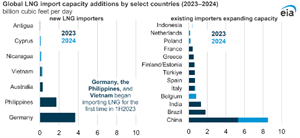Three countries began importing LNG this year, and more will follow
Global liquefied natural gas (LNG) import capacity is set to expand by 16%, or 23 billion cubic feet per day (Bcf/d), by the end of 2024 compared with 2022. Our estimate is based on trade press and data by the International Group of Liquefied Natural Gas Importers (GIIGNL). In the first seven months of 2023, three countries—Germany, the Philippines, and Vietnam—began importing LNG for the first time. By the end of next year, we expect Antigua, Australia, Cyprus, and Nicaragua to start importing LNG. Several more countries are in advanced stages of developing LNG import capacity.
Over the past 10 years (2013–22), global LNG import capacity—called regasification capacity—has grown by 49% (45.8 Bcf/d) to reach 140.0 Bcf/d across 48 countries. By the end of 2024, we expect 55 countries to have LNG regasification terminals with a combined capacity of 163 Bcf/d. Globally, available regasification capacity exceeds LNG imports. Historically, up to 39% of global regasification capacity is used every year. Spare regasification capacity, most of which is in Japan, South Korea, and China, allows countries to meet occasional demand spikes, particularly in winter. Last year, global LNG trade used 37% of available regasification capacity, or 51.7 Bcf/d.
Regionally, we expect Asia to lead the growth in global regasification capacity, accounting for 52% (11.9 Bcf/d) of the total capacity additions in 2023 and 2024. Europe accounts for 38% (8.6 Bcf/d), and the rest of the world accounts for 10% (2.3 Bcf/d).
Asia: In China, 8.5 Bcf/d of new regasification capacity is being built. China was the country that had the most LNG imports in 2021, but its LNG imports declined in 2022, mainly because of the COVID-19-related economic slowdown. India expects 1.3 Bcf/d of LNG regasification capacity to be online by the end of 2023 with two new terminals: Dhamra LNG and Chhara LNG. The Philippines and Vietnam both started importing LNG in 2023. In addition to recently opened regasification terminals, the Philippines will add 1.1 Bcf/d of regasification capacity in 2023, and Vietnam will add 0.1 Bcf/d by the end of 2024.
Europe: LNG regasification capacity is set to expand by one-third by the end of 2024 compared with 2022 in response to reduced natural gas imports by pipeline from Russia. Germany began importing LNG this year as operators fast-tracked construction of regasification capacity by using Floating Storage and Regasification Units (FSRUs). Three new terminals are online, and three more terminals are under construction and are expected to be online by the end of 2023. These terminals have a combined regasification capacity of 3.7 Bcf/d. Eleven other countries will each add between 0.1 Bcf/d and 0.7 Bcf/d of new or expanded regasification capacity for a combined 4.9 Bcf/d of additions. Cyprus is also expected to start importing LNG in 2024.
Rest of world: We expect Brazil to add 1.8 Bcf/d of regasification capacity in 2023. Australia, although also one of the world’s three largest LNG exporters, will add 0.3 Bcf/d of regasification capacity through a new offshore terminal on its eastern coast. Both Nicaragua and Antigua and Barbuda will become new LNG importers, with a combined regasification capacity of 0.1 Bcf/d.
Related News
Related News

- ExxonMobil halts 1-Bft3d blue hydrogen project in Texas
- Aramco and Yokogawa commission multiple autonomous control AI agents at Fadhili gas plant
- Ukraine will resume gas imports via Transbalkan route in November
- Mitsubishi to inject $260 MM into Brunei LNG project
- Freeport LNG (U.S.) on track to take in more natgas on Thursday after unit outage





Comments